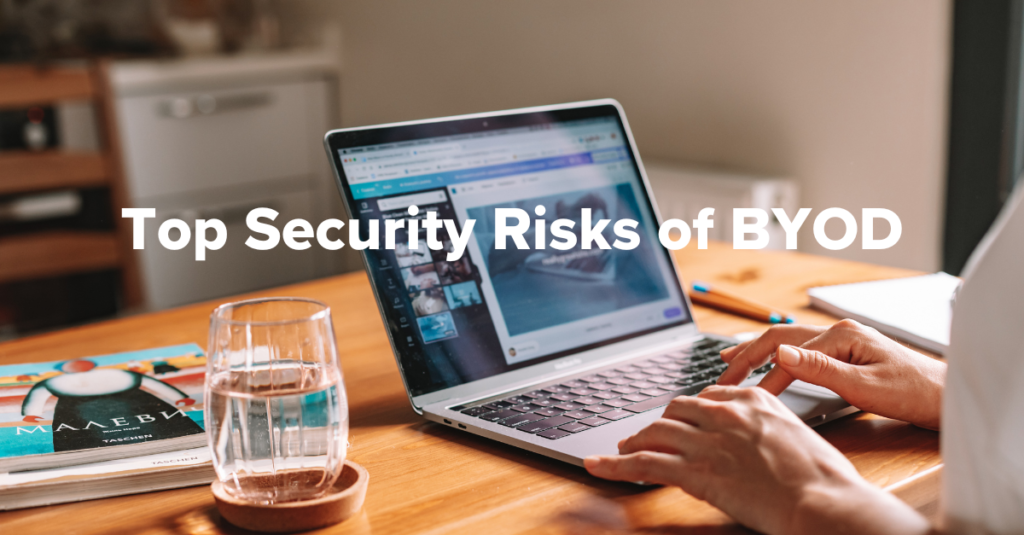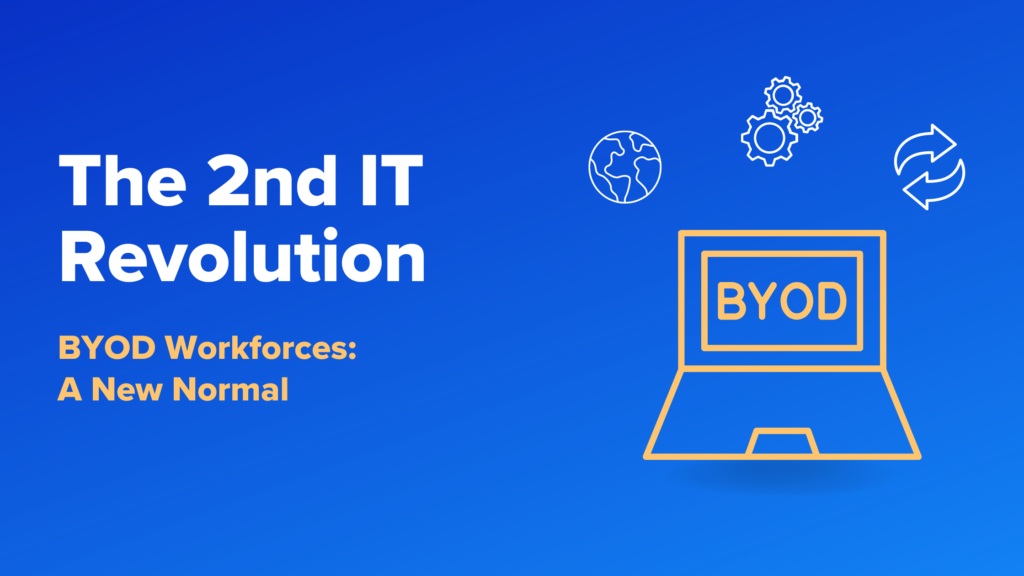
Over the past few years, it has become clear that enabling Bring Your Own Device (BYOD) workforces does wonders for employee productivity and morale. However, BYOD programs can also increase an organization’s exposure to cyberattacks and security risks if the right solutions and policies are not put in place.
In this article, we explore some of the most common BYOD security risks, best practices for preventing them, and how Venn can help. And if BYOD is a newer concept to you or your company and you’d like to dive deeper into the concept itself, you’re welcome to discover more about what BYOD is here.
9 Most Common BYOD Security Risks
BYOD programs that allow employees to use personal laptops, tablets and mobile phones, can bring significant benefits to a company and its employees. However, they can also introduce a range of security threats and vulnerabilities. These are nine of the most common BYOD security risks.
#1. Data Leakage
Data breaches are most organizations’ primary cybersecurity concern. Exposure of customer or business data can result in brand damage, regulatory penalties, legal fees, and other harm to the organization. BYOD policies increase the potential for data to be leaked or breached. Corporate and customer data stored on personal devices may be more vulnerable to theft and data loss if these devices are insecure or stolen. Additionally, employees may take this data with them when they leave the organization, which could leak this data to competitors or open it to other abuse.
#2. Use of Insecure Public Wi-Fi
Laptops and mobile devices are designed to make it easy for a user to connect to wireless networks. In fact, the default setting on these devices is usually to automatically connect to any network that the device recognizes (i.e. knows the SSID and password). As a result, BYOD systems are likely to be connected to public Wi-Fi networks available in airports, coffee shops, and other public places.
These insecure public networks can introduce various threats to the device and the organization. An attacker eavesdropping on the network traffic can read any data sent over the network. Additionally, many computers have relaxed security for networks that a user has labeled as a “private” network, which may enable an attacker to compromise a device if a public network is mislabeled as private.
#3. Insecure Devices
BYOD policies enable employees to use their personal devices for work purposes. This means that the company doesn’t own the device and lacks the ability to control how it is used, configured, and secured.
Personal devices used under a BYOD program may be less secure than corporate devices. For example, a user may not have installed a security update on their device that closes a vulnerability in the operating system. As a result, the device may be vulnerable to exploitation by an attacker.
#4. Mixed-Use Devices
Devices used under a BYOD policy are inherently mixed-used devices. In addition to being used for business, an employee also retains the right to use their own device for a range of personal purposes.
This mixed-use introduces various risks to the organization. Phishing attacks targeting the user’s personal email account or text messages could grant an attacker access to corporate data or systems. Additionally, the personal device could be used for purposes that are deemed inappropriate or in violation of corporate policies. To combat this issue, companies can utilize solutions like Blue Border, which completely separates work and personal on a single device, thereby ensuring company data security if a personal device were to be compromised.
#5. Lack of Control
Under a BYOD program, an organization doesn’t own the devices that some of its employees use for work. This means that the organization has limited ability to control or enforce corporate policies for these devices.
Under a BYOD policy, an organization can block access to corporate systems and applications from devices that violate corporate policy (out of date, missing antivirus, etc.). However, it can’t restrict what users can do with their personal devices, which increases the risk of malicious apps, phishing attacks, and other potential threats to the organization.

#6. Inadequate Policies
BYOD policies introduce various additional security risks to the organization. Some of these risks are caused by how employees use their personal devices both for and outside of work. If an organization hasn’t implemented and distributed BYOD security policies, then employees may not understand their responsibilities under the program. This can increase an organization’s security risk as employees may not be aware that the actions they’re taking threaten the company’s cybersecurity and are in violation of corporate security policies.
#7. Lost/Stolen Devices
BYOD systems can contain a range of sensitive information. Even if corporate information is not downloaded to the device, it might contain saved passwords and other authentication credentials that provide access to corporate systems. This information saved on a device may be at risk if the device is lost or stolen. Often, personal devices have weak PINs (1234, 0000, etc.) or no PIN for convenience. Even if they do, systems exist for cracking these PINs. As a result, an attacker with access to an employee’s device may be able to gain access to the data it contains, even if full-disk encryption (FDE) is enabled on the device.
#8. Insecure Remote Work Infrastructure
BYOD programs often require an organization to provide remote access to its infrastructure and applications. If a personal device is used remotely or is not connected to the corporate LAN, some gateway must exist for granting access.
This publicly exposed remote access infrastructure can introduce security risks for the organization as well. For example, virtual private networks (VPNs) are a common choice for offering secure remote access. However, they also grant unrestricted access to the corporate network and have no built-in security inspection capabilities, which can be problematic if a user’s credentials or device is compromised by an attacker.
#9. Regulatory Compliance Challenges
Most organizations are subject to at least one data privacy or protection law. The General Data Protection Regulation (GDPR), Payment Card Industry Data Security Standard (PCI DSS), and the Health Insurance Portability and Accountability Act (HIPAA) all have requirements for managing access to and securing certain types of protected data.
BYOD workforces can complicate regulatory compliance because sensitive, protected data may be accessible to or stored on personally owned devices. This increases the difficulty of maintaining and demonstrating compliance since an organization may lack full visibility into and control over these devices. Luckily, there are solutions for enabling BYOD workforces that have compliance built-in.
How to Protect Your Business Against BYOD Threats
Many of the potential security threats that BYOD programs introduce can be managed by implementing a solid BYOD policy and the right security controls. Some best practices for implementing secure BYOD workforces include:
- Authenticate devices: Verify user and device identity using multi-factor authentication (MFA) and contextual data.
- Use a virtual private network (VPN): A VPN encrypts traffic between a remote user and the corporate network, protecting against eavesdroppers.
- Regularly update software: Regular software updates help to close vulnerabilities before they can be exploited by an attacker.
- Implement remote wiping: A remote wipe allows sensitive data to be cleared from lost or stolen devices.
- Encrypt data: Data encryption renders data unreadable without knowledge of the encryption key, reducing the threat of a lost or stolen device.
- Segment the network: Network segmentation prevents potentially compromised BYOD devices from accessing sensitive or critical corporate systems.
- Formalize a device approval process: A formal device approval process helps to limit BYOD systems to supported, secure devices.
- Educate employees: Employee education informs users of their responsibilities under a BYOD program and the threats that they should look out for.
- Establish an Acceptable Use Policy (AUP): An AUP defines what can and cannot be done using corporate resources.
- Conduct regular audits and monitoring: Regular audits and monitoring enable the organization to identify and correct potential issues before they become a problem.
For a comprehensive guide on ensuring your business’s safety with BYOD, explore more about BYOD security best practices.

Venn’s BYOD Security Solution – Blue Border™
BYOD security risks largely stem from the fact that an organization lacks control over the personal devices that employees use for work. As a result, corporate data is placed at risk, and stolen or compromised devices could grant an attacker access to company applications or systems.
Venn is revolutionizing how businesses enable BYOD workforces, removing the burden of buying and securing laptops or dealing with virtual desktops. Our patented technology provides companies with a new approach to securing remote employees and contractors working on unmanaged computers.
With Venn’s Blue Border™, work lives in a company-controlled Secure Enclave installed on the user’s computer, enabling IT teams to secure company data while ensuring end-user privacy.
More Blogs



